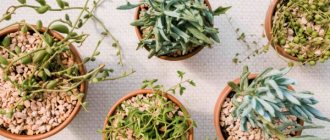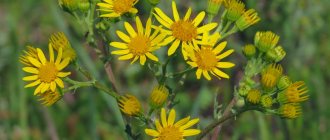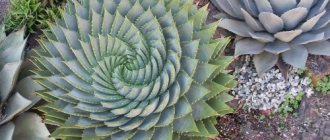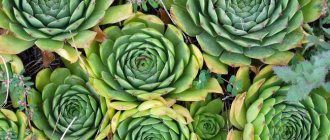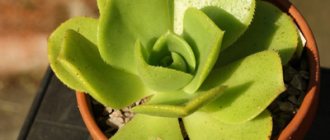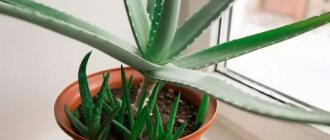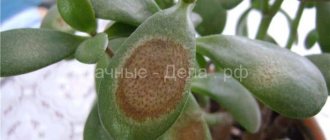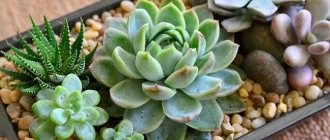Large-tongued ragwort , however, does without either “gray hair” or “baldness.”
Large-tongued ragwort is a tall evergreen vine with fleshy leaves up to 8 cm long - green or variegated, decorated with yellowish-white stripes and spots.
The shape of the leaves is triangular or pentagonal, with a protruding central segment, the same “tongue” with clear straight sides, from which this type of ragwort received the Latin name “Senecio macroglossus” (“big tongue”).
In nature, this vine grows in South Africa, including in the dry areas of the province of Natal. This is where another name for the plant comes from: “Natal ivy” .
In appearance , the large-tongued ragwort is indeed similar to ivy, but has a characteristic difference: typical succulent leaves: dense, “well-fed”, with a waxy coating.
The fact that Natal ivy is a leafy succulent explains the origin of another name under which this vine is often sold: kleiniya . This name is given in honor of the German botanist Klein, who studied the succulent forms of ragworts.
In addition to attractive leaves with a reddish central vein and brownish-purple, violet cuttings, “Natal ivy” is decorated with small pale yellow flowers similar to daisies in winter and early spring.
The sap of the plant is poisonous. If it comes in contact with the skin, it can cause irritation and allergic reactions; if it gets inside the body, it can cause poisoning.
Therefore, large-tongued ragwort should not be grown where there are pets and small children.
Large-tongued variegated groundsel, what it looks like, what family it belongs to
Macroglossus belongs to the Asteraceae family or, as it is also called, Asteraceae. It can be either in the form of a vine, or in the form of a subshrub, shrub, or tree. Due to its high resistance to weather changes, it can grow anywhere on the planet.
Common groundsel
Depending on the species and local climate, the shape of the plant can vary significantly. When the seed pods are empty, the stems do not always become pubescent - they, like the leaves, may remain bare. Leaves can be whole or dissected, oval or heart-shaped, elliptical, lobed or pinnate.
This is interesting! The cross came to Europe from Africa, Namibia. Under the positive influence of climate, it reached a length of 50 cm and was quite sprawling, which is why it attracted biologists of that time. Taking it for examination, they distributed the seeds throughout the world.
Large-tongued ragwort is an evergreen vine. The leaves of the flower are triangular or pentagonal in shape, with one end protruding more than the others. This is the “tongue” from which the plant gets its name. The length of the leaves can reach 8 cm. Their color is variegated, green with yellowish-white spots and stripes.
Note! The sap of the plant is poisonous, so it is better to grow it away from animals and children.
Popular varieties of ragwort
The tallest representative of the Senecio species is the perennial ragus of the Haworth variety. Its length can reach 30 cm, shoots can be either single or branched. Even when hatching, the leaves acquire silvery fluff; in adult plants they are up to 6 cm long. The flowers of Senecio Haworthii are dim, yellow or orange, and have a spherical shape.
Other varieties of godson:
- Creeping evergreen groundsel is a perennial, not covered with silvery down. From the description of the culture it is clear that it reaches a height of only 20 cm and has rough stems (6 mm). The leaves, shaped like lancelets, can be up to 4 cm long. All flowers are painted white and have the shape of baskets. The leaves are distinguished by a greenish-blue tint.
- Senecio cultivar Herreianus. Its second name is Nailleaf. The leaves of the crop are similar in appearance to gooseberries and have slightly pointed ends. This variety needs to be grown in a sufficiently lit place, but at the same time it should not be exposed to sunlight - the leaves can get burned.
- Raspberry variety Fulgens. It is distinguished by bright, almost fiery, flowers on thin stems, round flattened leaves of a bluish tint. Many gardeners also call it Kleinia Fulgens.
- Raspberry Blue differs not only in color. This plant has arrow-shaped leaves, from under which flower stalks emerge in the form of baskets. The leaves can be either flattened or quite voluminous.
- Greater Tolstovaty ragwort was discovered in Madagascar and brought by researchers. It was large in size and could reach a height of half a meter. Moreover, the leaves themselves were no more than 5 cm, everything else was stems. Senecio major Crassissimus can be green or have a blue or gray tint.
- Ficus ragus. It has recumbent, weakly branched stems and narrow elongated leaves of gray-green color. In April-May, small greenish-white flowers appear on it.
Blooming ragwort mikaniiformes
Many people, especially beginners, confuse ragwort with ivy because of the shape of the leaves of some of its varieties. This comparison is incorrect, since these are representatives of different families.
Biological description
All godsons are classified as succulents, i.e. plants capable of heating up moisture reserves and living off them in depleted growing conditions. The species diversity of senecio is enormous, including coniferous greens, pea-like greens, and climbing ones like ivy. Their shoots can grow like vines, or they can form bushes and even trees. Moreover, they can be pubescent and bare, erect and drooping, and the shape of the leaves of this group of plants makes it almost impossible to cover. In nature, there are more than 3000 of them. And they all have only one thing in common - the classic inflorescence-basket.
Senecio is grown both as a potted and garden crop. There are species that are intended for cutting. From ragworts alone you can create a rich collection of succulents, which will be very diverse.
Caring for ragwort flowers at home
Large-tongued ragwort is undemanding in care, but still has its own characteristics that must be taken into account.
Illumination and temperature conditions
Common groundsel Senecio vulgaris
Raspberry grows best in a sunny area, so when planting in the garden, it is not advisable for taller plants to tower over it. At the same time, you need to protect it from strong northern winds so that the thin rods do not freeze. When growing in pots, it is best to place the flower on a windowsill facing west or east.
Important! Raspberry is very difficult to tolerate severe frosts and any cold snaps, so there is no need to place it in a room where the temperature is below +7 degrees. It is worth making sure that in winter it does not rise above +15 degrees. In the summer, homemade ragwort can be placed outside in the sun during the day if the air temperature does not exceed +23 degrees.
Rowley plant variety
Watering rules and humidity
Raspberry is a plant that thrives when the air indoors or outdoors has low humidity, regardless of temperature. It is noteworthy that it is not necessary to moisten the leaves or the entire plant, and if dust accumulates, you just need to wipe it with a dry napkin or rag.
The frequency of watering the ragwort varies depending on the time of year. In summer, the soil is moistened 2 days after its top layer is covered with a dry crust. In autumn, watering should be reduced, and in winter, stopped altogether. Do this smoothly, gradually reducing the amount of water or increasing the time interval between waterings.
Fertilizing and soil quality
It is advisable to start feeding the groundsel in March and gradually stop fertilizing in August. Feeding should be done no more than once every 2 weeks. You can use a simple fertilizer for succulents or a special one for aster plants.
The soil is bought in specialized stores or prepared independently. It should consist of sand and leaf soil. When purchasing soil, it is important to check with the seller whether the soil for ragwort contains nutrients. The soil should be loose with neutral acidity.
Flower container size
If the ragwort flower is small or just bred, you need to choose a pot with a diameter of no more than 6 cm. For more mature plants, the diameter will be larger.
The soil
The easiest way is to use ready-made soil mixtures made for cacti and succulents. If it is not possible to buy a ready-made substrate, you need to select a loose, moderately nutritious and acid-neutral soil. It can be a mixture of leaf soil and coarse sand (2:1); some specimens grow better in a sandy-clay substrate. Much depends on what the plant is used to, therefore, when purchasing an already grown specimen of a flower in a pot, you should pay attention to what it grew in, or ask the seller about the composition of the soil.
Features of plant transplantation
Rowley's ragwort Senecio rowleyanus - what kind of flower
An adult ragwort does not need frequent replanting. Gardeners do not recommend doing this more often than once every 2 or 3 years.
Important! Only planted indoor ragwort flowers need to be replanted every year, constantly renewing the soil and replenishing it with nutrients.
Young plants
Useful video
Important tips for caring for succulents can be found in the video:
Correct care and attentive attention to the plant’s signals about a problem will ensure that indoor ragwort will not disappoint its owner for a long time. And its aesthetic appearance will allow the succulent to be included in a wide variety of flower ensembles.
READ ABOUT OTHER SUCCULENTS: GASTERIA, COTYLEDON, LITHOPS, REJUVENER, SEDUM, a href=”https://botanicoved.com/komnatnye/sukkulenty/raznovidnosti-sukkulenty/pahifitum.html” rel=”noopener” target=”_blank”> PACHYPHYTUUM, PORTULACARIA, SEDEVERIA, STAPELIA, HAWORTIA, EONIUM, ECHEVERIA.
Flowering and dormant period of the plant
Rowley's godson: home care and methods of reproduction
During the flowering period, ragwort most of all needs nutrients and proper care. It is imperative to monitor air humidity and temperature. The latter should be within +24 degrees during the growing season and +15 degrees during the dormant period.
Type and shape of flowers
When flowering occurs, you can notice differences in the inflorescence of individual species. They can be collected in scutes or remain solitary, have a small or large size. The flowers themselves can be basket-shaped.
Reproduction of Senecio macroglossus
Reproduction of ragwort can be carried out using cuttings, layering, seeds and leaves.
Leaf and stem cuttings
By cuttings we mean small parts of the stem, about 9 cm long. A couple of lower leaves are removed from them and left overnight in the open air. During this time, the stem dries out a little, and it is planted in a specially prepared sandy soil mixture. It is desirable that there are no weeds in it. You can control the climate in which the cuttings will be located and move them if necessary. Several stems are planted in one pot. Transplantation is done after rooting.
By layering
To obtain layering, you need to place several small pots with prepared soil with nutrients near the already mature ragwort. After this, the leaf or even the stem must be bent so that it touches the soil in the additional pot. After rooting, the shoots need to be trimmed as carefully as possible.
Seeds
Gardeners do not recommend propagating ragwort using seeds, since they are rarely available fresh in stores. If you still managed to buy them, then several seeds, pre-moistened with water, are sown in one pot. This is done so that sprouts appear on them. Watering should only be done with a sprayer so as not to flood the seedlings.
Growing and Reproduction
Note! Cultivation occurs until the cotyledon phase begins. Then each sprout is transplanted into a separate pot with a diameter of no more than 6 cm.
Mr. Summer resident recommends: medicinal properties and contraindications
Most varieties of ragwort have medicinal properties. Thanks to the beneficial substances included in the composition, the plant acts as an anti-inflammatory, analgesic, and anticonvulsant. Also, some types accelerate wound healing, act as an anthelmintic, suppress attacks of bronchial asthma, and help with hypertension, cholecystitis, colitis, and stomach ulcers.
It is forbidden to use ragwort for persons suffering from glaucoma, circulatory disorders, liver or kidney pathologies. Raspberry is not recommended for pregnant and lactating women, as it is poisonous.
The plant is harvested in the summer using roots, stems, leaves, and flowers. All parts are well dried. Store for two years in boxes or bags.
Possible problems in growing ragwort
The plant is quite resistant to climate change and various pests, but it needs to be looked after constantly to prevent aphids, mites or scale insects from appearing.
Diseases and pests
The most common pest is aphids, which settle on young stems or cuttings. This is accompanied by a sharp cessation of development of the entire plant, as well as yellowing of the leaves and browning of the flowers. To get rid of aphids, you need to constantly spray the leaves with insecticides.
If a spider mite appears, a web will certainly appear on one side of the leaves. The leaves also darken noticeably and may wrinkle. To get rid of the pest, you need to increase the air humidity and spray the entire plant with warm water.
Large-tongued ragwort is grown both in the garden and in pots. It can also be cultivated for further cutting of flowers into bouquets. The plant differs in appearance depending on the species and climatic conditions of the area where it grows.
How to grow from seeds?
The easiest way to grow ragwort from seeds is self-sowing. If you like this plant and don’t care where it grows, you can let propagation take its course. The seeds are easily dispersed by the wind (like dandelion). Bushes grown in the wrong place can either be replanted or weeded out.
Seeds of graceful groundsel without stratification have low germination.
When sowing them for seedlings, this procedure must be carried out. With self-seeding, nature itself will take care of this. If you don't trust your plants to reproduce on their own, there are three ways to do it under control:
- Sow the seeds directly into the ground in the desired location.
- Buy seedlings at the market.
- Grow it yourself.
On sale you can find hybrids (F1) of graceful groundsel. It is not recommended to let them self-sow.
You can collect your own seeds in the fall or purchase them at the store. Growing ragwort seedlings is not particularly difficult - it is not a capricious plant. But still, certain conditions must be observed. There are two ways to stratify the seeds of this plant.
Method 1 (one month before sowing):
- melt the snow and soak two cotton pads in melt water;
- Place ragwort seeds on one of them, cover with a second disk and place them in a zip-lock bag;
- place the bag of seeds under the freezer in the refrigerator (temperature should be 1 - 5 oC) for a month;
- once every three days the bag should be opened briefly for ventilation;
- In the last week, use alternating temperatures, that is, keep it in the refrigerator at night and on the windowsill during the day.
Method 2:
- prepare a container with soil;
- sow seeds in moist soil;
- close the container with a lid or cling film;
- place in the refrigerator for a month;
- then proceed as in method 1.
How to grow graceful ragwort seedlings:
- After stratification, seeds are sown in late March - early April.
- The container is filled with soil, the seeds are laid out on the surface and sprinkled with a layer of 0.5 - 0.7 cm of soil.
- The surface is moistened with a spray bottle.
- Covered with a lid, film, glass.
- Ventilation is carried out periodically.
- When shoots appear, remove the cover.
- The soil should be moderately moist - neither drying nor waterlogging should be allowed.
- After two to three weeks, when the seedlings have three or four true leaves, the seedlings are plucked. To do this, you can use either separate cups or another container - larger and deeper.
- After two and a half months, the seedlings are planted in a permanent place.
